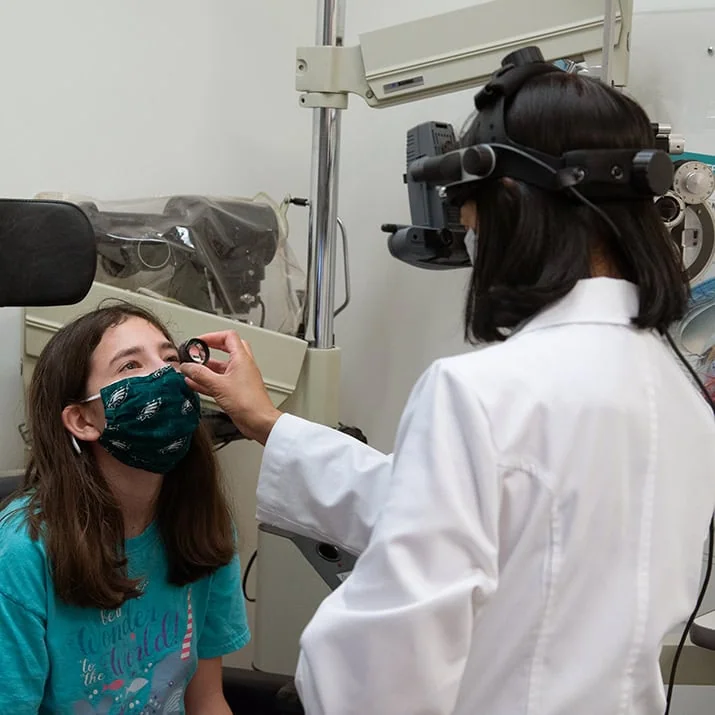Conjunctivitis (Pink Eye)
Commonly known as “pink eye,” conjunctivitis is an irritation or infection of the membrane that covers the white of the eye and the inside lining of the eyelid.
Overview
What is conjunctivitis (pink eye)?
Conjunctivitis, also known as pink eye, is an inflammation of the thin, clear tissue that lies over the white part of the eye and lines the inside of the eyelid. It can be highly contagious, often spreading rapidly in schools and daycares, but is rarely serious.
What are the different types of conjunctivitis?
There are four different forms of conjunctivitis — viral conjunctivitis, bacterial conjunctivitis, allergic conjunctivitis, and conjunctivitis resulting from irritation. The most common forms of conjunctivitis are caused by either a viral or bacterial infection. Both types are highly contagious and can spread through direct and indirect contact.
Viral conjunctivitis
- Viral Conjunctivitis, often characterized by eye redness and a watery discharge, is often accompanied by symptoms such as a cold, sore throat or fever.
Bacterial conjunctivitis
- Bacterial conjunctivitis, often caused by a staph or strep bacteria, presents itself in the form of eye redness and often a mucus-like discharge.
Allergic conjunctivitis
- Allergic conjunctivitis affects both eyes and is a response to an allergy-causing substance such as pollen.
- Intense itching, tearing and inflammation of the eyes — as well as sneezing and watery nasal discharge, are all common side-effects of allergic conjunctivitis. However, most cases can be controlled with allergy eye drops.
Conjunctivitis resulting from irritation
- Irritants such as a chemical splash, environmental irritant/foreign body or contact lens are responsible for this form of conjunctivitis.
- Symptoms vary depending on the cause
When to call the doctor
Conjunctivitis with serious symptoms such as vision loss, pain, suspected foreign body or chemical burn should be seen immediately. If conjunctivitis symptoms are mild but persist for more than 24 hours, make an appointment with your doctor. Contact users should stop wearing lenses as soon as symptoms begin, and carefully monitor their condition to avoid a more serious issue.
Other conditions that cause eye redness can often be serious and may present a feeling that something is in your eye, blurry vision or light sensitivity. If you’re experiencing any of these issues, seek urgent care immediately.
Symptoms
What are the symptoms of conjunctivitis (pink eye)?
Pink eye affects roughly six million people in the U.S. each year, and is one of the most common infections in adults and children. So what are the symptoms?
Burning
This is common for pink eye brought on by chemicals or allergens.
Itching
Usually appears in one or both eyes and is often caused by allergens.
Redness
Is seen in one or both eyes in the white of the eye or corner of the eyelid.
Blurred Vision
Frequently occurs in one or both eyes and is usually a result of allergens or a foreign body.
Tearing
Excess tear production is a common sign, and may be accompanied by watery eyes or inflammation.
Diagnosis
How is conjunctivitis (pink eye) diagnosed?
In most cases, pink eye can be straightforward and diagnosed by history and doctor exam.
In rare cases, your doctor may request lab tests or a culture for high-risk patients and patients who suspect their condition is caused by a foreign body in the eye, a serious bacterial infection, or a sexually transmitted disease.

Treatment & Prevention
How is conjunctivitis (pink eye) treated?
Although pink eye can be a highly contagious and common infection, the good news is it’s totally treatable! Treatment depends on the cause of the conjunctivitis – your doctor may recommend artificial tears, lid hygiene, OTC or Rx eye drops.
How can conjunctivitis be prevented?
Since viral and bacterial pink eye is highly contagious and can easily spread from person to person, it’s important to follow these simple steps to reduce your chances of infection.